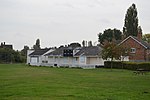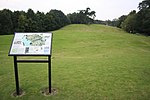Godmanchester railway station
1847 establishments in EnglandDisused railway stations in CambridgeshireEast of England railway station stubsFormer Great Northern and Great Eastern Joint Railway stationsGodmanchester ... and 4 more
Pages with no open date in Infobox stationRailway stations in Great Britain closed in 1959Railway stations in Great Britain opened in 1847Use British English from March 2017
Godmanchester railway station was a railway station situated in the town of Godmanchester in Huntingdonshire, England. It was situated on the Huntingdon to St Ives line.
Excerpt from the Wikipedia article Godmanchester railway station (License: CC BY-SA 3.0, Authors).Godmanchester railway station
The Avenue, Huntingdonshire
Geographical coordinates (GPS) Address Nearby Places Show on map
Geographical coordinates (GPS)
| Latitude | Longitude |
|---|---|
| N 52.3262 ° | E -0.1752 ° |
Address
Bridge Place car park
The Avenue
PE29 2EP Huntingdonshire
England, United Kingdom
Open on Google Maps











